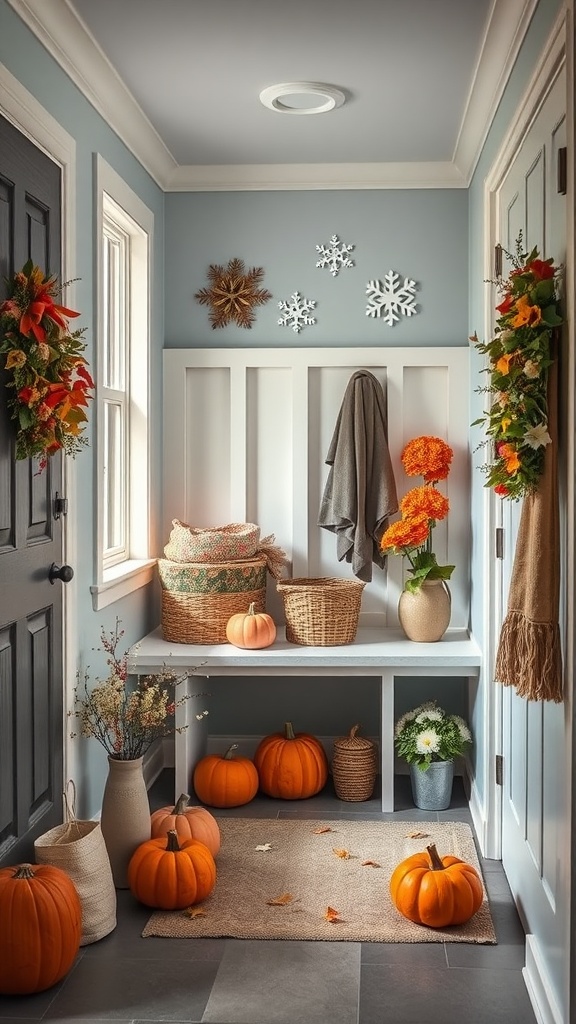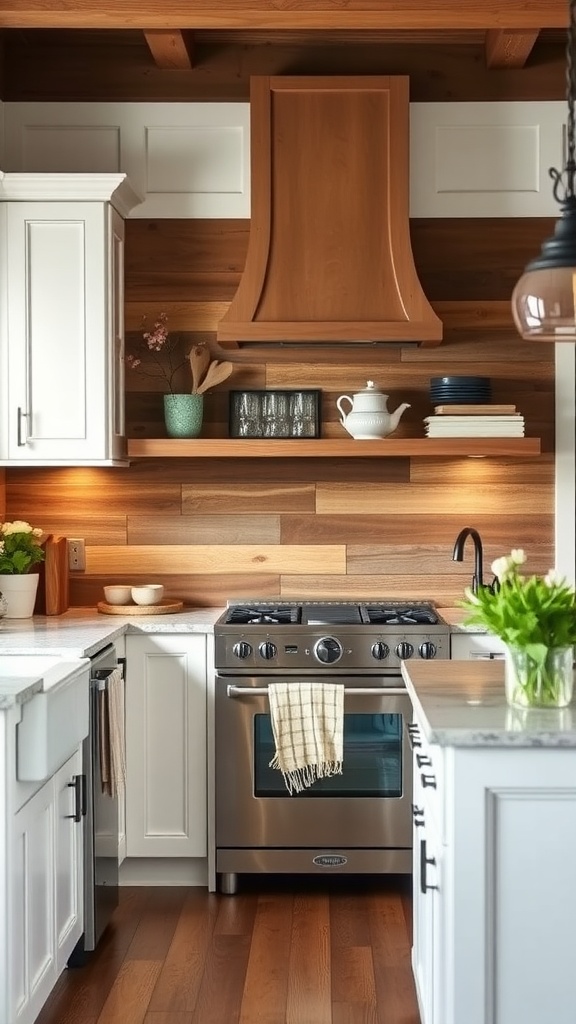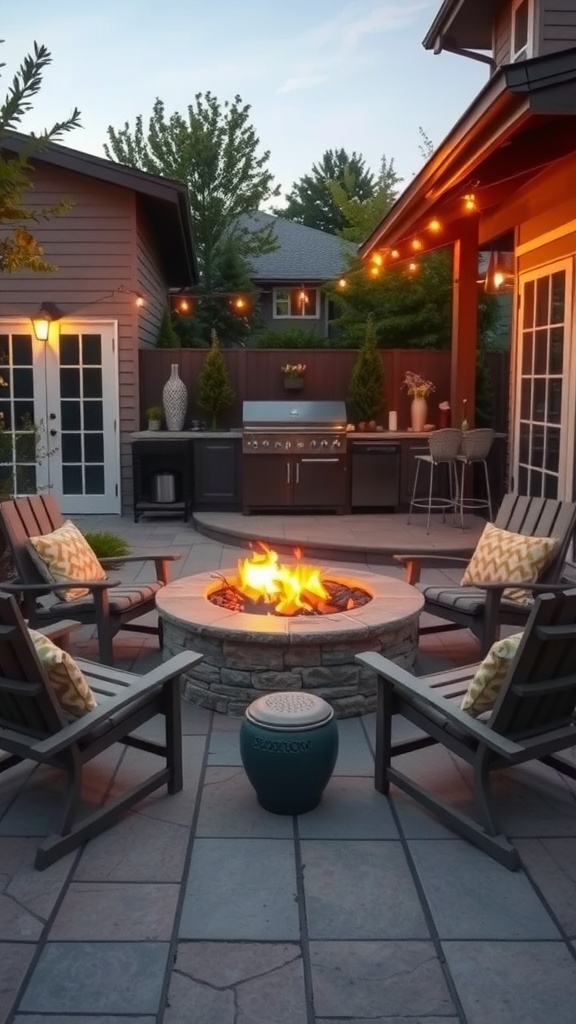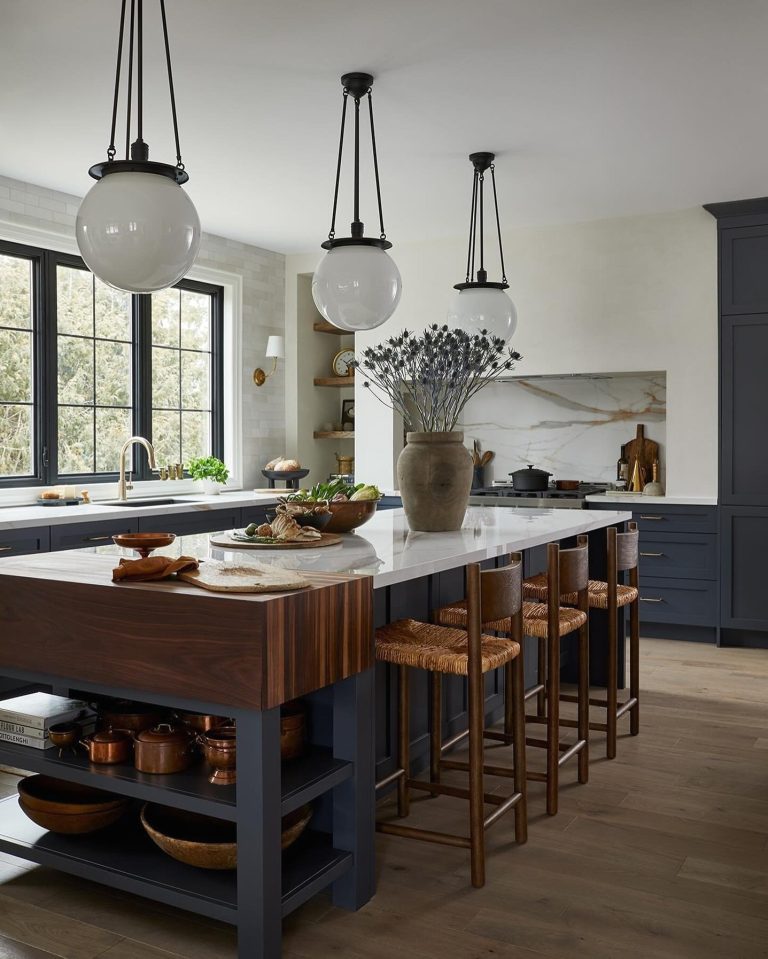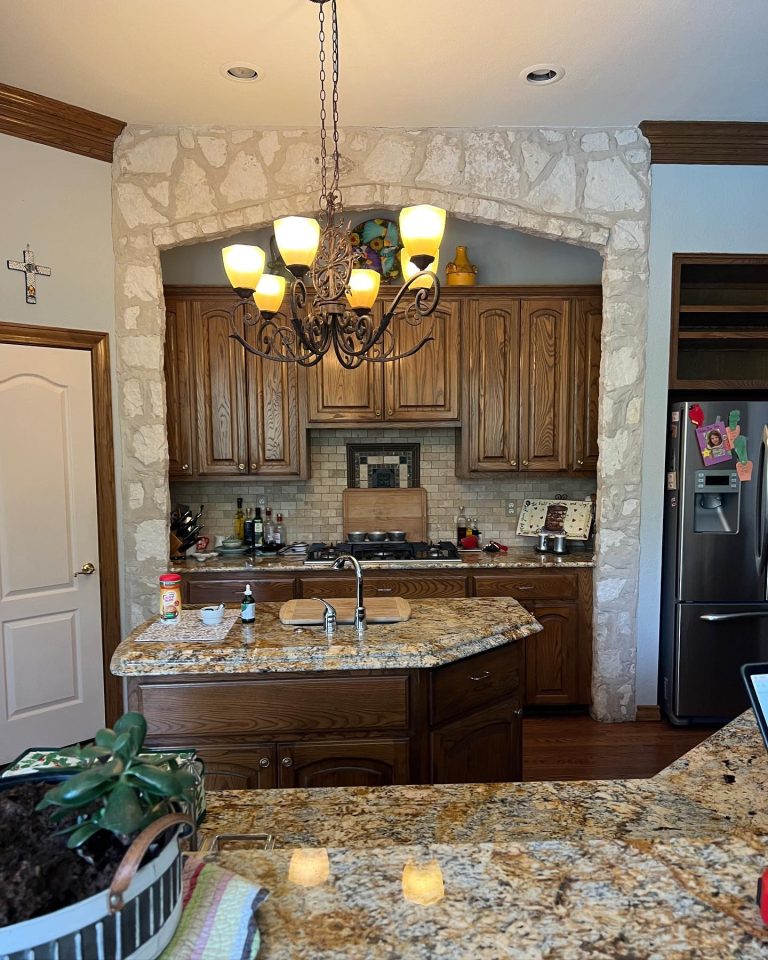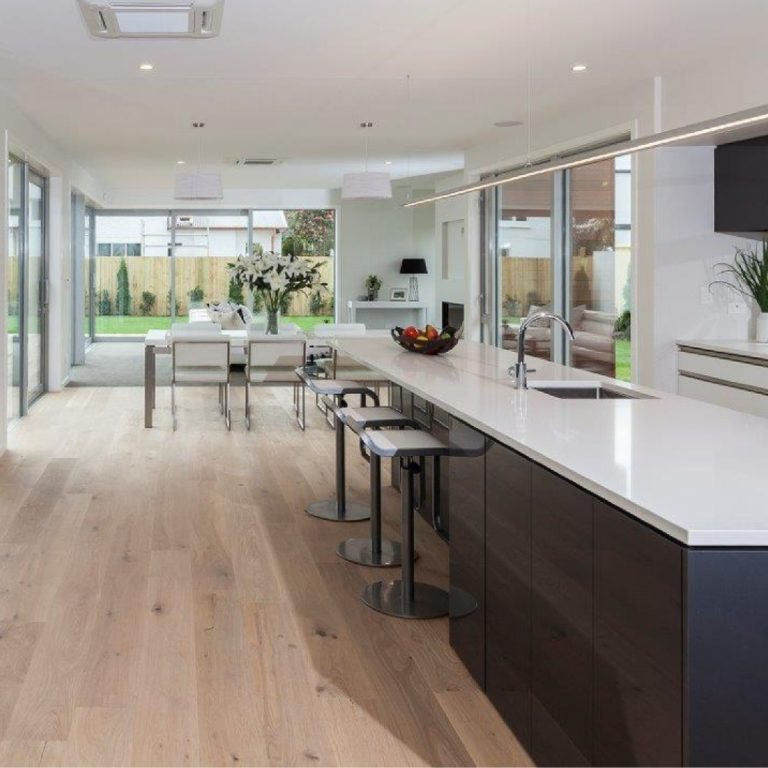21 Creative Mud Kitchen Ideas for Endless Outdoor Fun
Creating a mud kitchen can be a fun and messy way for kids to explore their creativity and play outdoors. These 21 mud kitchen ideas will spark your imagination and help you design an engaging space for little chefs to get hands-on with nature. From simple setups to more elaborate installations, there’s something here for everyone to enjoy!
Natural Materials for Authentic Play
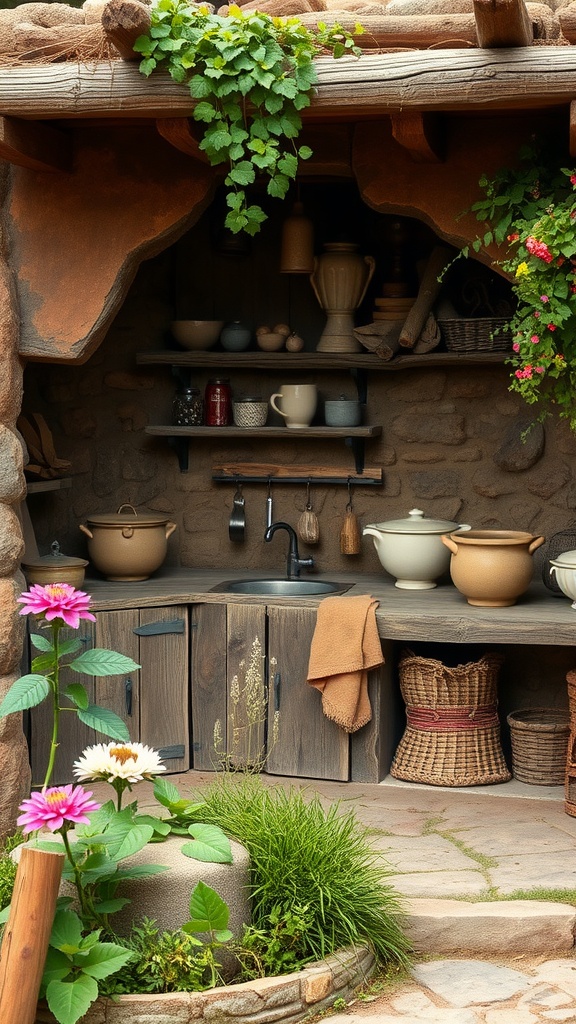
This beautiful mud kitchen is a perfect example of using natural materials for creative play. The rustic design includes wooden shelves, clay pots, and woven baskets, all of which inspire imaginative cooking and outdoor fun.
The earthy tones and textures invite children to engage with their surroundings. Plants and flowers nearby add a touch of nature, enhancing the experience even more. Kids can mix mud, water, and leaves, turning their kitchen into a vibrant hub of activity.
Using materials like wood and clay not only connects children with nature but also encourages tactile exploration. It allows them to experience different textures and smells. Each item in this kitchen serves as a tool for learning and discovery, making it a fantastic play space.
Incorporating Colorful Accessories
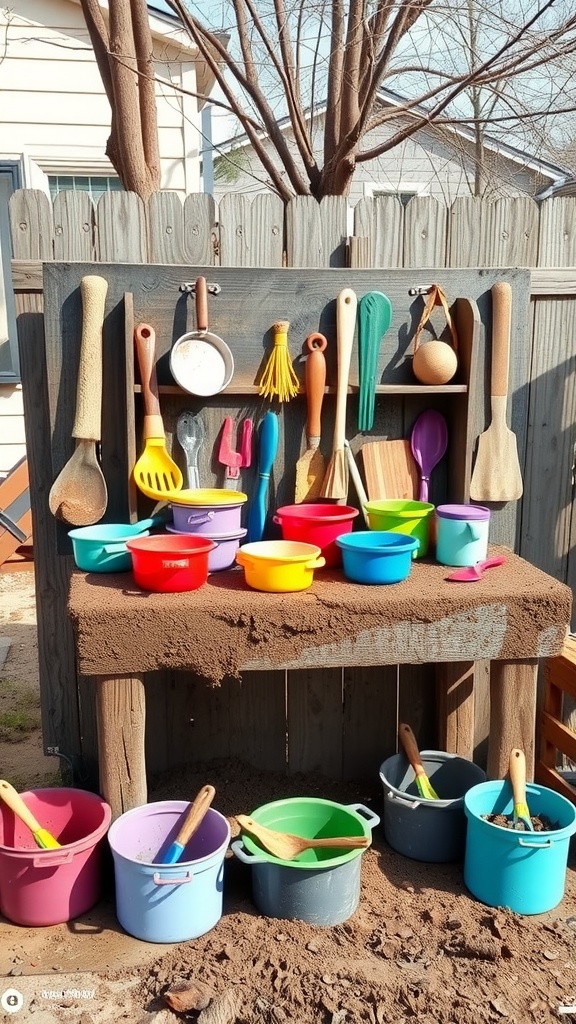
Colorful accessories can really bring a mud kitchen to life! In the image, we see a delightful setup filled with vibrant bowls and tools. The bright colors invite kids to engage and play, making the experience enjoyable and stimulating.
The assortment of buckets in various shades adds a cheerful touch. Using different colors can help children learn about shades while they play. Each bucket can serve a unique purpose, whether it’s mixing, pouring, or storing their creations.
Look at the fun utensils hanging on the wall! They are not just practical but also add to the visual appeal. Wooden spoons and spatulas in playful colors offer kids a chance to experiment with different textures and shapes.
This setup encourages creativity and imaginative play, allowing little ones to mix dirt, water, and whatever else they can find. A colorful mud kitchen is more than just a play area; it’s a space for exploration and learning!
Mud Kitchen with a Focus on Sensory Play
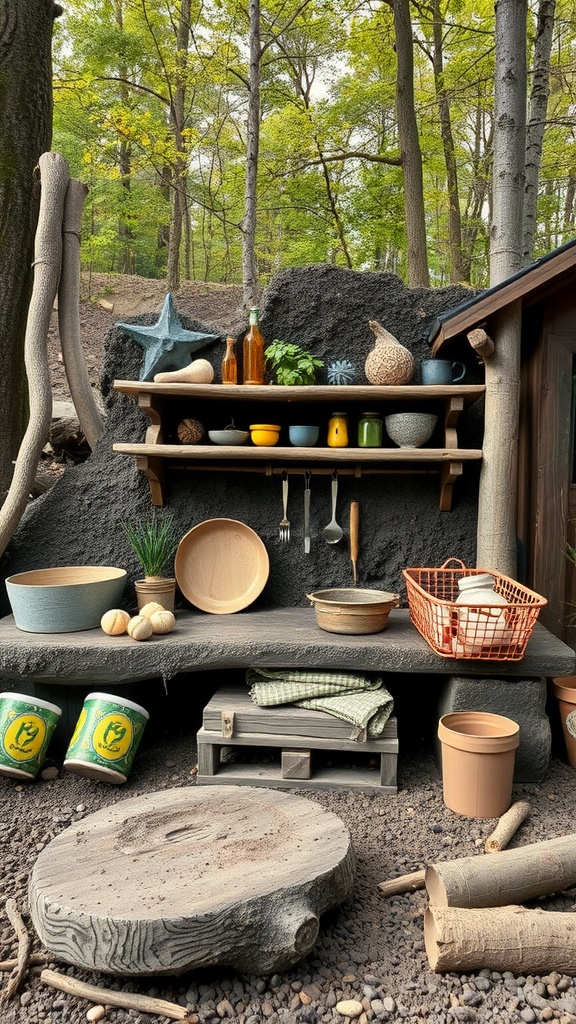
This mud kitchen is a fantastic spot for sensory play! The rustic wooden shelf is filled with various bowls, pots, and utensils that invite creativity. Children can mix, pour, and explore different textures and colors. The earthy tones of the kitchen blend perfectly with the surrounding trees, enhancing the natural feel.
Playing with mud and natural materials sparks curiosity. Kids can use their hands to feel the different textures and create mud pies or potions. The simple setup encourages imaginative play, allowing them to experiment freely. From the wooden log serving as a table to the colorful pots, every element serves a purpose in this playful space.
Encouraging sensory play helps children develop fine motor skills. Activities like scooping and pouring also promote hand-eye coordination. Plus, it’s a great way for kids to connect with nature while having fun. The mud kitchen is not just a play area; it’s an experience that stimulates creativity and learning.
Themed Mud Kitchen Ideas
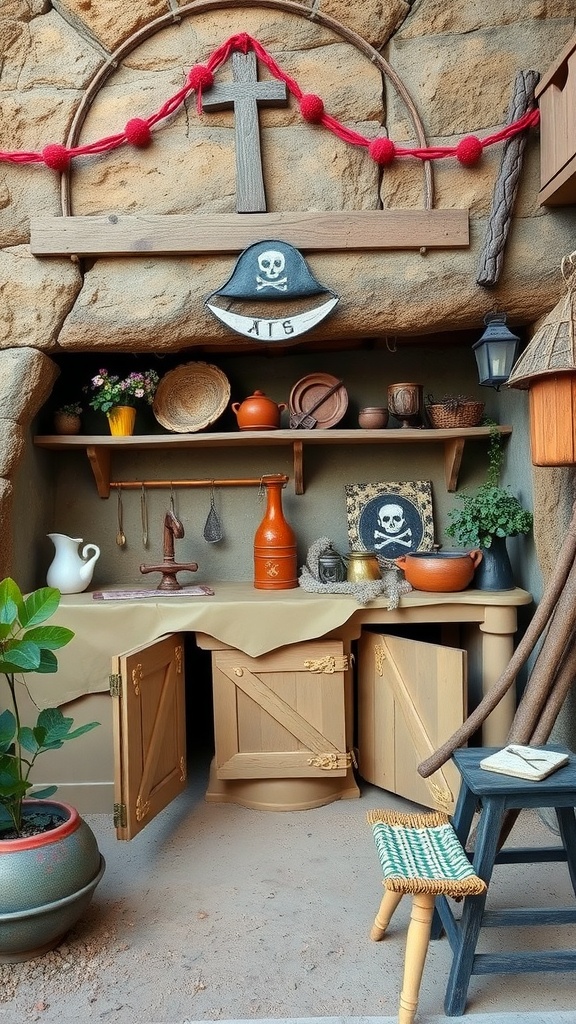
Themed mud kitchens are a fantastic way to spark creativity and imagination in outdoor play. This particular setup highlights a pirate theme, which is both fun and engaging for kids. The kitchen features rustic elements that give it a unique character, making it a perfect backdrop for endless adventures.
Notice the pirate hat and skull on the wall, which immediately sets the scene. Kids can pretend they are cooking up treasure or preparing meals for their crew. The use of rustic shelves and various pots creates an authentic feel, encouraging imaginative play. The natural surroundings, like the plants and earthy tones, blend beautifully with the theme.
Such a themed kitchen not only provides a space for play but also allows children to learn about teamwork and storytelling. They can create their own pirate tales while mixing mud pies or serving ‘special’ brews. These creative setups transform simple outdoor activity into an exciting experience full of pretend play.
Functional Storage Solutions for Tools
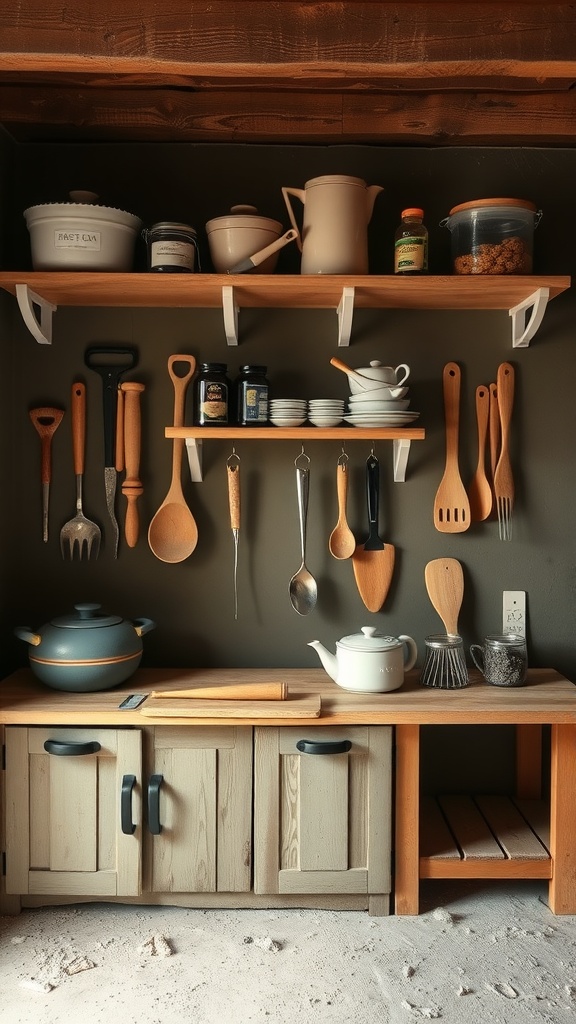
A well-organized mud kitchen is essential for encouraging creativity in outdoor play. In this image, we see a charming setup that maximizes space while offering easy access to tools and utensils.
The shelves above are lined with various kitchen items. Wooden spoons, spatulas, and pots hang neatly, making it easy for little hands to grab what they need. This setup is perfect for kids who want to dive into mud pies and pretend cooking.
The lower section features a sturdy countertop with storage cabinets beneath. This design allows for safe and secure storage of more delicate items, keeping everything tidy. The combination of open shelving and closed storage balances accessibility with neatness.
Utilizing wall space creatively, this mud kitchen provides ample room for tools without cluttering the play area. It shows that functional storage solutions can inspire imaginative play while keeping everything organized.
Incorporating Edible Plants Nearby
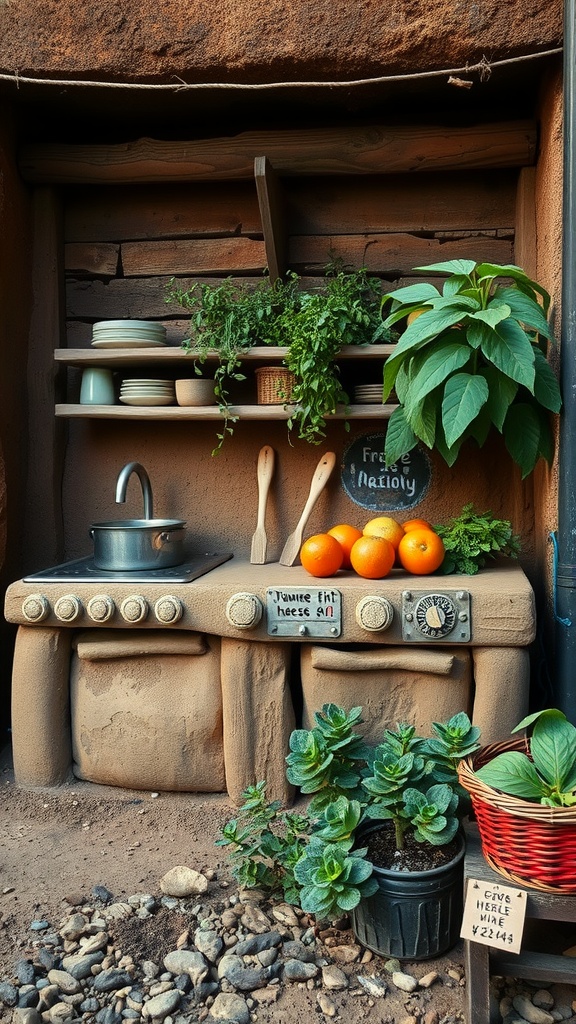
Creating a mud kitchen is a delightful way to encourage imaginative play. Imagine a setup where kids can pretend to cook using natural ingredients they find in the garden. This image shows a charming mud kitchen, complete with shelves and a little cooking area. Surrounding it are vibrant edible plants like herbs and fruits, which make the space feel alive and inviting.
Having edible plants nearby is a fantastic idea. Not only do they add greenery, but they also offer a hands-on learning experience. Kids can learn about growing food while playing. Imagine their excitement as they pick fresh herbs for their ‘recipes’ or grab an orange for a pretend snack. Herbs like basil and mint, along with simple fruits, can be both fun to grow and tasty to use.
To take this concept further, consider planting a small garden with easy-to-grow favorites. Strawberries, cherry tomatoes, and radishes are great options. Kids can help with watering and caring for the plants, enhancing their connection to nature. This not only provides a fun element to playtime but also teaches responsibility and the basics of gardening.
Creative Outdoor Sink Designs
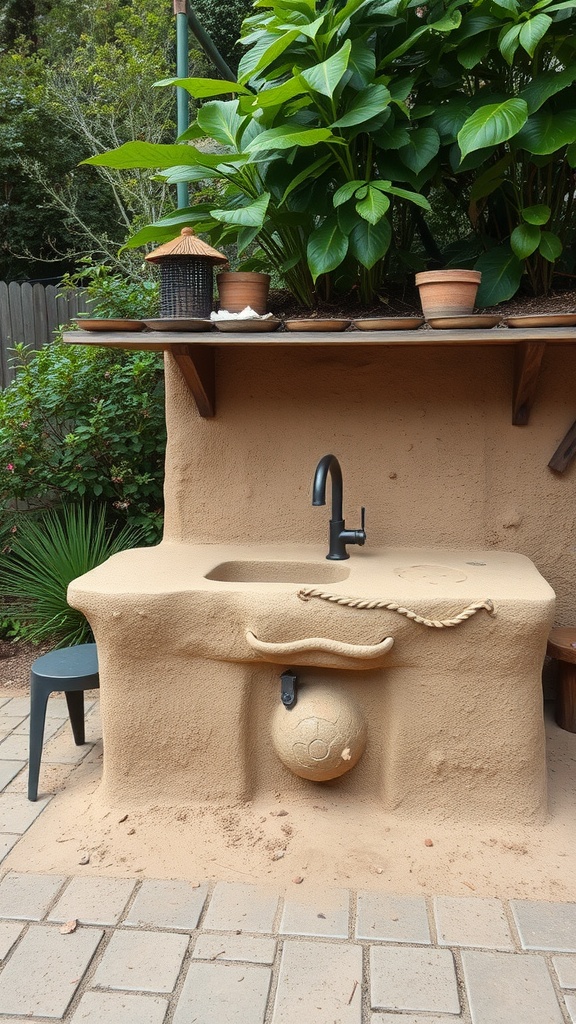
Creating a unique and functional outdoor sink can be a delightful addition to any mud kitchen. The image showcases a lovely outdoor sink that blends beautifully with nature. It’s made from earthy materials, giving it a rustic charm.
This sink features a functional tap, perfect for washing hands or rinsing off muddy hands after play. The basin is shallow, making it easy for kids to reach. A rope detail adds a playful touch.
The surrounding plants provide a lush backdrop, enhancing the outdoor experience. A shelf above the sink holds small pots, which can be used for herbs or decorative items. This design encourages creativity and brings a touch of the garden into playtime.
Having an outdoor sink encourages kids to engage with nature. It allows them to clean up after messy projects or even help with gardening tasks. It’s all about making outdoor play fun while keeping things tidy.
DIY Mud Kitchen from Pallets
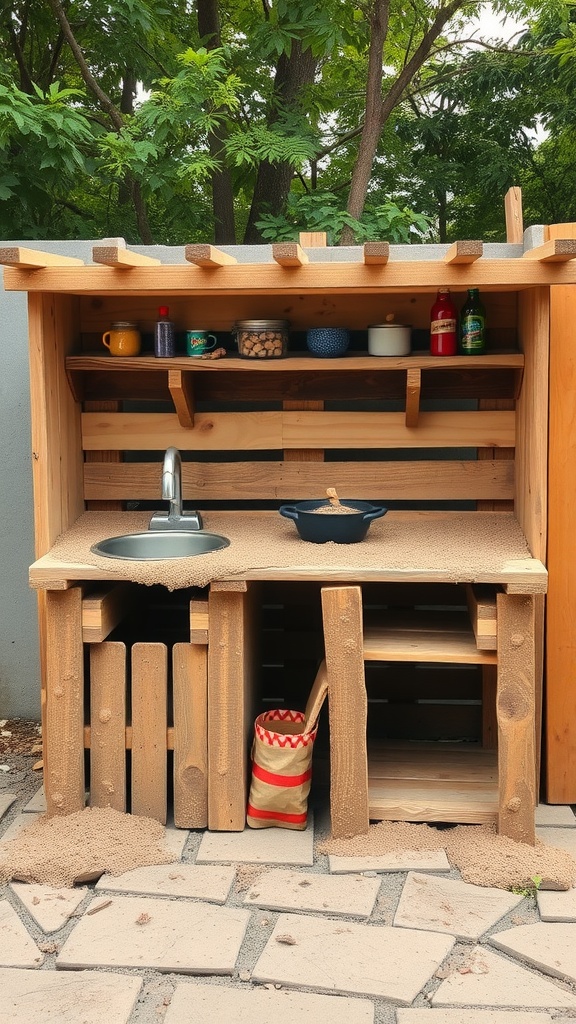
Creating a DIY mud kitchen from pallets is a fun and creative project. The image shows a charming wooden kitchen setup that kids will love. It features a sink, shelves, and a playful design that sparks imagination.
The kitchen is made from sturdy pallets, giving it a rustic look. The top has a slatted roof, providing a bit of shade while kids play. On the shelves, there are various pretend cooking items, like a pot and some colorful bottles. This encourages kids to engage in imaginative play.
The work surface is large enough for multiple children to play together, promoting social skills. The use of natural materials like wood blends well with outdoor spaces. This mud kitchen can easily be customized with more features, like additional storage or even a small herb garden nearby.
Setting up a mud kitchen provides opportunities for messy play, enhancing sensory experiences. Kids can mix mud, water, and whatever else they find in nature, allowing them to explore and create freely. This project not only keeps them entertained but also encourages creativity and outdoor activity.
Using Natural Elements for Decoration
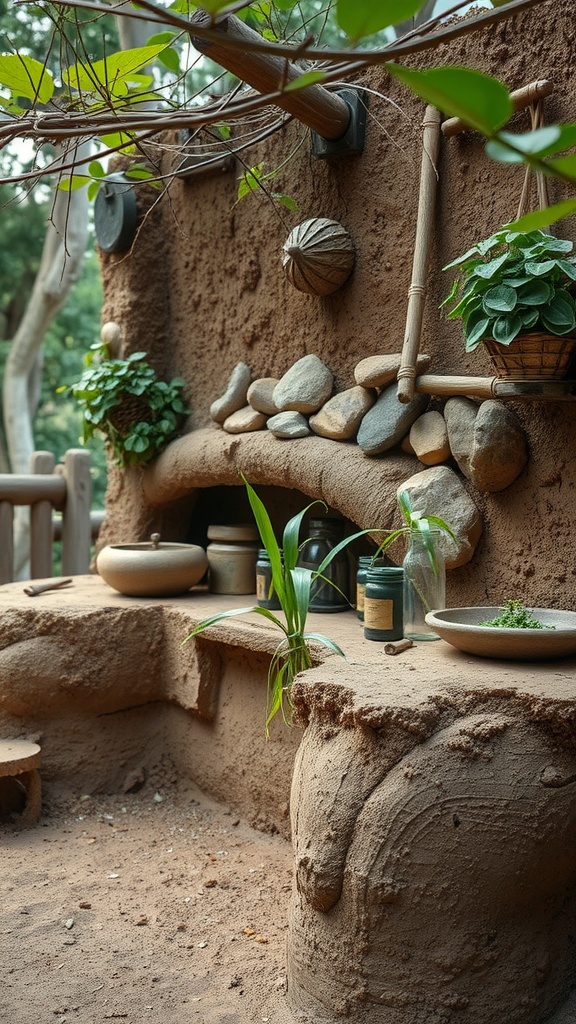
Creating a mud kitchen can be a fun and creative way to engage kids with nature. This image shows a beautiful setup that utilizes natural materials like clay, stones, and plants. It’s a wonderful example of how simple elements can come together to create an inviting space.
The wall is made from earthy tones, giving it a rustic feel. The stone shelf provides a perfect spot for storing kitchen tools. Small pots and plants add a touch of greenery, making the space lively and cheerful.
Incorporating natural elements not only enhances the look of the kitchen but also encourages children to explore and connect with their environment. They can use leaves, sticks, and rocks in their play, fostering creativity and imagination.
Using these materials helps ground the play experience in the real world. Kids can learn about textures, colors, and even the importance of taking care of plants while having fun.
Incorporating Water Play Features
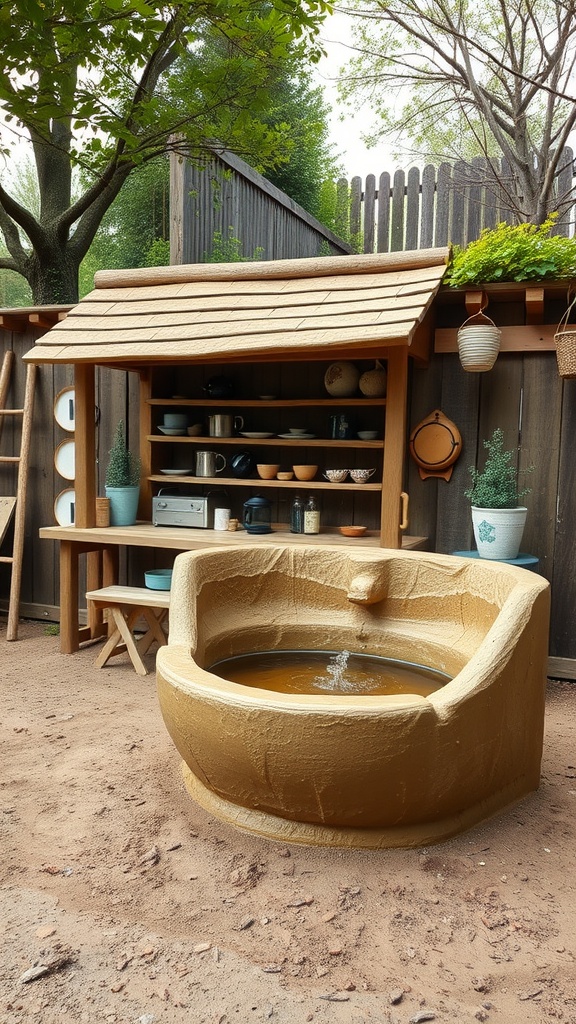
Creating a mud kitchen is a fun way to encourage outdoor play. Water features can add an extra layer of excitement. The image shows a lovely setup with a large, round basin, perfect for splashing and mixing. This feature invites kids to get their hands dirty while enjoying the feel of water.
The natural materials used in the design blend well with the surrounding area. The wooden kitchen shelf offers a place for utensils and pots, making it easy for kids to engage in imaginative play. Water play is not just fun; it also helps develop motor skills. Children can learn about pouring, mixing, and cleaning in a hands-on way.
Adding water play elements to a mud kitchen can transform it into a sensory haven. Consider adding small cups for pouring, or even a simple pump to circulate water. This encourages teamwork as kids share the space and create together. Overall, combining mud and water creates a delightful experience for little ones to enjoy.
Sustainable Mud Kitchen Practices
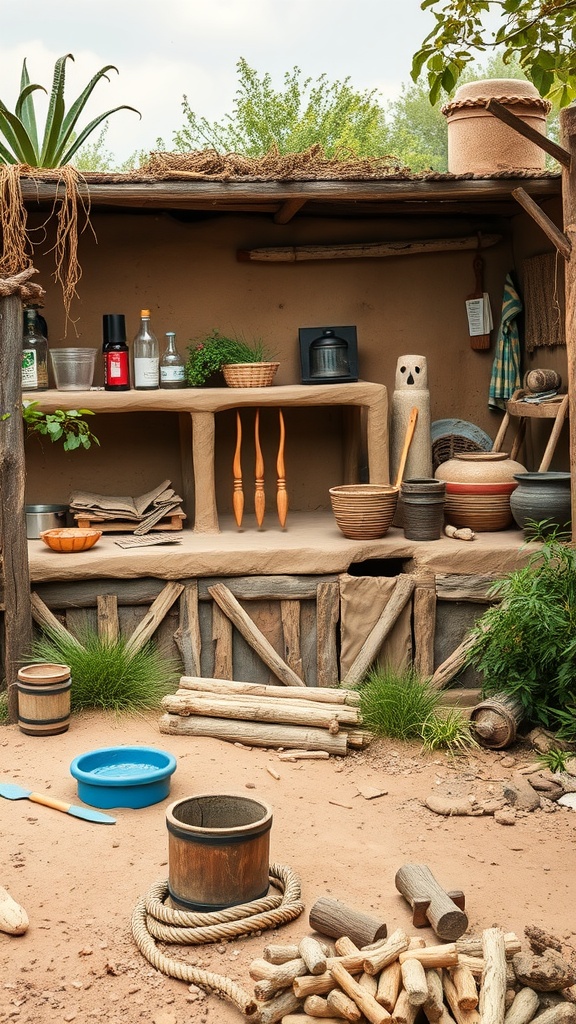
A mud kitchen is a fantastic way to introduce kids to nature while encouraging creativity. The image shows a beautifully crafted mud kitchen setup. With natural materials and simple tools, it creates a playful environment.
The use of items like wooden bowls, pots, and natural grasses reflects eco-friendly practices. These materials are not only sustainable but also safe for children to use. Opting for second-hand or recycled items adds to the charm while being kind to the planet.
Incorporating plants like the aloe vera seen in the image enhances the space. They not only look great but can also teach kids about the importance of plants in our ecosystem. Outdoor play promotes a connection with nature, making sustainable mud kitchens a great choice for families.
Parents can encourage kids to gather natural materials from the yard, such as sticks and stones, to use in their cooking play. This not only fosters imagination but also instills a sense of responsibility towards the environment.
Inviting Social Interaction in Play
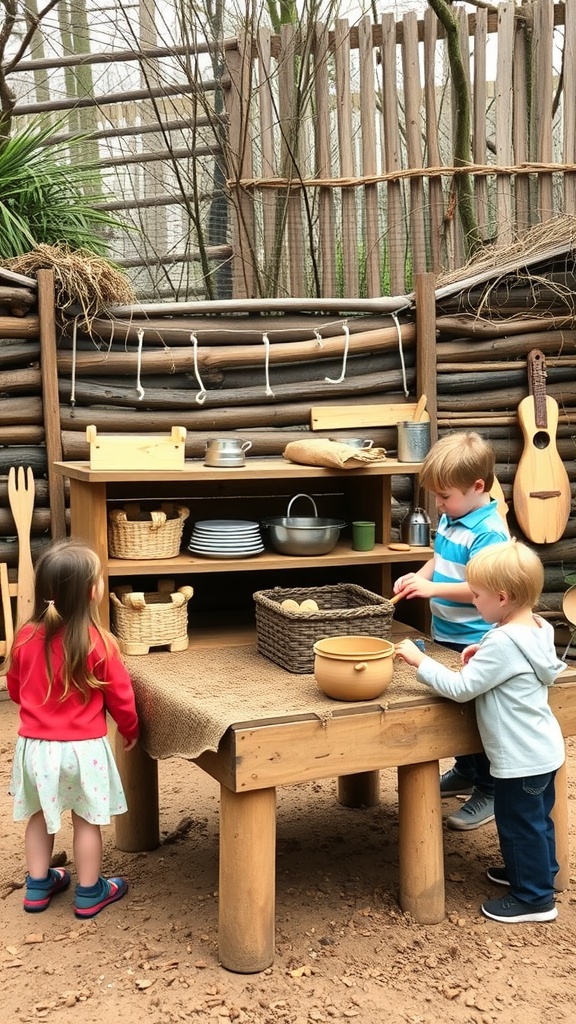
This mud kitchen is a fantastic place for kids to gather and play together. With its rustic wooden design and an array of play items, it sparks creativity and collaboration.
The setting features two children engaged in imaginative cooking. One child is busy with a pot, while the other explores baskets filled with pretend food. This encourages teamwork and sharing, making it a social hub.
The open layout allows children to move freely, promoting interaction. They can chat, share ideas, and learn from each other. The mud kitchen transforms ordinary play into fun, cooperative experiences!
Creating a Multi-Zone Cooking Area
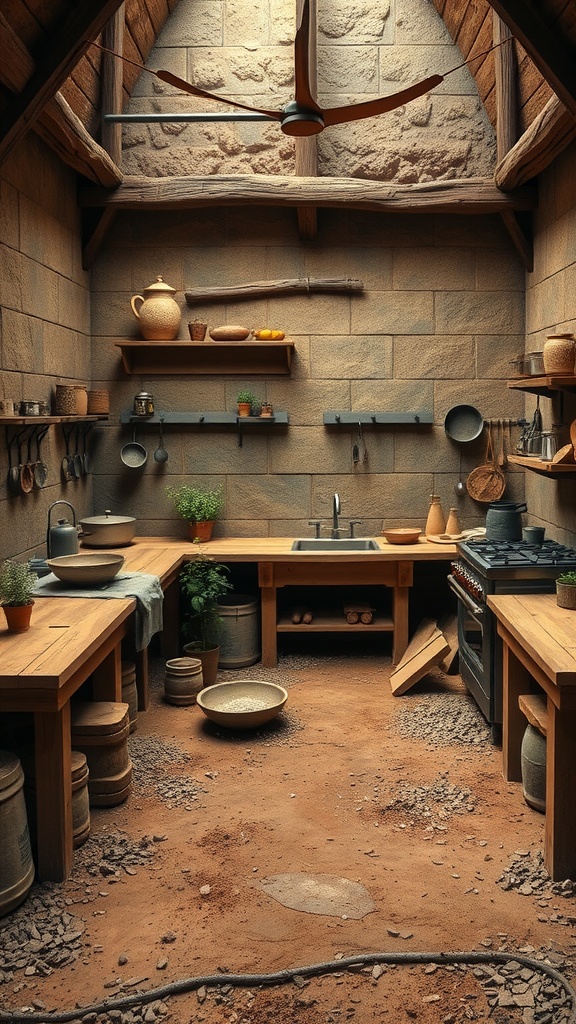
A multi-zone cooking area can transform your outdoor cooking experience. In the image, you can see a beautifully designed open kitchen that blends rustic charm with functionality. This setup features multiple work areas, allowing for different cooking tasks to happen simultaneously. The wooden tables are spacious, perfect for meal prep or even serving food.
The use of natural materials, like stone walls and wooden shelves, adds a cozy feel. You could easily imagine friends gathering around, each person contributing to the meal. The layout encourages collaboration and creativity, whether you’re baking, chopping, or mixing.
Having distinct zones for prep, cooking, and even washing can streamline your cooking process. Adding features like potted herbs or a simple sink brings practicality to the design. This kitchen isn’t just a place to make food; it’s an inviting space for shared experiences.
Think about how you can create your own multi-zone cooking area. With some smart planning and a few key features, your outdoor kitchen can become a bustling hub of activity.
Seasonal Decorations for a Mud Kitchen

Decorating a mud kitchen for the seasons can be such a fun way to get kids excited about outdoor play. In the image, you can see a cozy setup that captures the essence of autumn. The warm tones and natural elements create a welcoming atmosphere.
The orange fruits and the leaves hint at the fall season, bringing a splash of color. These simple decorations can inspire kids to get creative. They can pretend to cook with the fruits or use the leaves as part of their imaginative play.
The arrangement shows how easy it is to bring in seasonal touches. A few pumpkins, some colorful foliage, and natural materials make a big difference. It’s all about creating an inviting space that encourages exploration and creativity.
Consider adding seasonal decorations like pinecones in winter or flowers in spring. Each season offers unique items that make for great play materials. The key is to keep it simple and let nature inspire the fun!
Incorporating Local Wildlife Elements
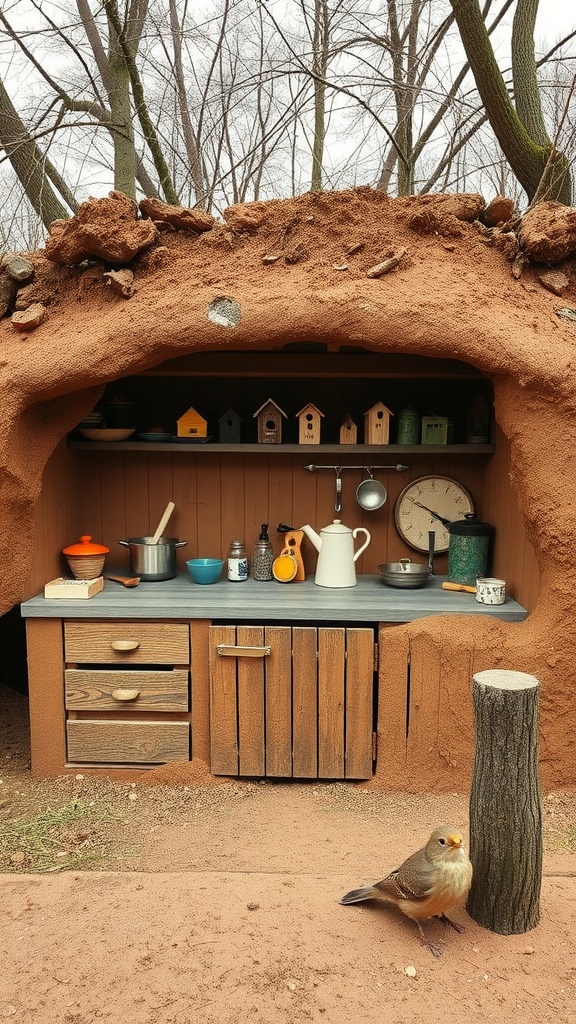
Imagine a charming mud kitchen nestled in nature, complete with earthy tones and rustic details. This setup not only invites creativity in play but also harmonizes with the surrounding environment. The kitchen features a lovely little bird perched nearby, showcasing how local wildlife can be part of the experience.
The rustic shelves hold playful items, such as pots and colorful bowls, blending seamlessly with the natural look. Incorporating elements like birdhouses enhances the outdoor theme, making it appealing to curious critters. This invites children to engage with the space, sparking their imagination as they mimic real cooking.
Adding wildlife elements encourages kids to observe nature. They can watch birds flutter around, learning about their habits and colors. This connection between play and wildlife fosters curiosity, making outdoor activities even more enjoyable.

